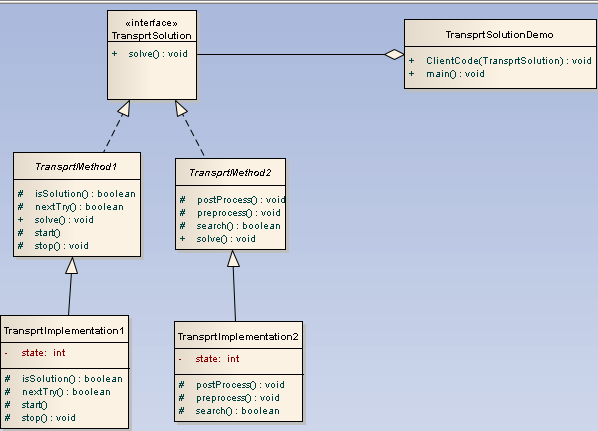Strategy meets Template
Strategy pattern defines a family of algorithms. Template method pattern defines the skeleton of an algorithm in an operation, deferring some steps to subclasses. If we combine those two patterns we can create separate strategy for all algorithms that differ significantly but make a further refinement of each strategy by utilizing the template method on the strategy that could have variations based on steps of execution. This could prevent horizontal expansion of strategies while utilizing all the variation on the each algorithm.
The UML example demonstrating solutions to transportation:
In this diagram, TransprtSolutionDemo is the main class with a main() method. This class is coupled
to the TransprtSolution interface. This interface is implemented by two abstract classes:
TransportMethod1 and TransportMethod2. Both abstract classes are extended by two subclasses:
TransprtImpl1 and TransprtImpl2, respectively. By comparing this diagram with the structural diagram
of the Strategy pattern, it is clear that TransprtSolution can be identified as Strategy, TransportMethod1
and TransportMethod2 can be identified as ConcreteStrategy (together with their subclasses), and
TransprtSolutionDemo can be identified as Context (client). The whole problem demonstrates solutions
to transportation. But there are two solutions: these are implemented in TransportMethod1 (with
TransprtImpl1) and in TransportMethod2 (with TransprtImpl2). TransprtSolutionDemo holds a
reference to TransprtSolution and creates objects of both implementations. With a simple call of the
method solve() of the TransprtSolution interface, the solution will be calculated by both algorithms
(the method is implemented in both implementation classes). These solve() methods in
TransportMethod1 and TransportMethod2 are implemented using the Template Method pattern.
